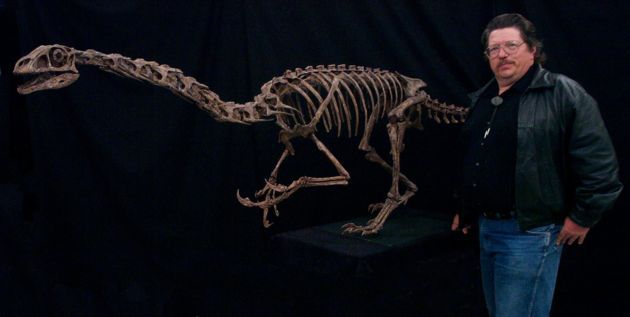New Dinosaur: Meat-Eating Killer or Vegetarian?

A newly discovered birdlike dinosaur found in Utah reveals clues about the transition from ornery predators like Velociraptor to plant-eating softies, scientists announced today.
The dinosaur, named Falcarius utahensis, walked on two legs about 125 million years ago. Its head would be level with an adult human chest.
Bones of many individuals found in a mysterious mass grave show the beast had many features common to known herbivores that show up more recently in the fossil record. While it had sharp, curved claws as long as a human hand, its short legs wouldn't have been very useful for chasing down prey.
"Falcarius shows the beginning of features we associate with plant-eating dinosaurs, including a reduction in size of meat-cutting teeth to leaf-shredding teeth, the expansion of the gut to a size needed to ferment plants, and the early stages of changing the legs so they could carry a bulky body instead of running fast after prey," said lead scientist James Kirkland of the Utah Geological Survey.
The discovery is detailed in the May 5 issue of the journal Nature.
Missing link
The new species belongs to a group known as therizinosaurs and are also part of a group called maniraptorans. Scientists think birds evolved from maniraptorans, which includes the vicious Velociraptor in the movie "Jurassic Park."
Sign up for the Live Science daily newsletter now
Get the world’s most fascinating discoveries delivered straight to your inbox.
Falcarius and Velociraptor had a common ancestor that's yet to be found, says Scott Sampson, chief curator at the Utah Museum of Natural History.
"We know that the first dinosaur was a small-bodied, lightly built, fleet-footed predator," said Sampson, also a geologist at the University of Utah. "Early on, two major groups of dinosaurs shifted to plant-eating, but we have virtually no record of those transitions. With Falcarius, we have actual fossil evidence of a major dietary shift, certainly the best example documented among dinosaurs. This little beast is a missing link between small-bodied predatory dinosaurs and the highly specialized and bizarre plant-eating therizinosaurs."
Mass grave
The researchers dug up nearly 1,700 Falcarius bones over the past three years in a 2-acre site south of Green River, Utah. They found adults and hatchlings. By combining the bones from various individuals, they were able to construct 90 percent of a complete adult skeleton.
The scientists can't say for sure what the creatures ate. But they had leaf-shaped teeth capable of shredding plants, rather than the frightening serrated, triangular chompers common to meat-eaters. A broad pelvis suggests a large gut needed to digest plants. The lower legs were stubby, possibly because they no longer needed to chase prey, the scientists figure.
Falcarius was 4.5 feet (1.4 meters) tall and 13 feet (4 meters) long.
The paleontologists don't know if Falcarius had feathers, but based on what's known about its relatives, they speculate it was covered with hair-like "proto-feathers."
Most scientists think modern birds evolved from dinosaurs.
Kirkland estimates hundreds and perhaps even thousands of dinosaurs died at the dig site in at least two episodes. Nobody knows what killed them.
Celina and Marina Suarez, geology graduate students at Temple University, speculate based on mineral evidence that the dinosaurs were drawn to a spring that occasionally poisoned them.
Related Stories
Robert is an independent health and science journalist and writer based in Phoenix, Arizona. He is a former editor-in-chief of Live Science with over 20 years of experience as a reporter and editor. He has worked on websites such as Space.com and Tom's Guide, and is a contributor on Medium, covering how we age and how to optimize the mind and body through time. He has a journalism degree from Humboldt State University in California.












